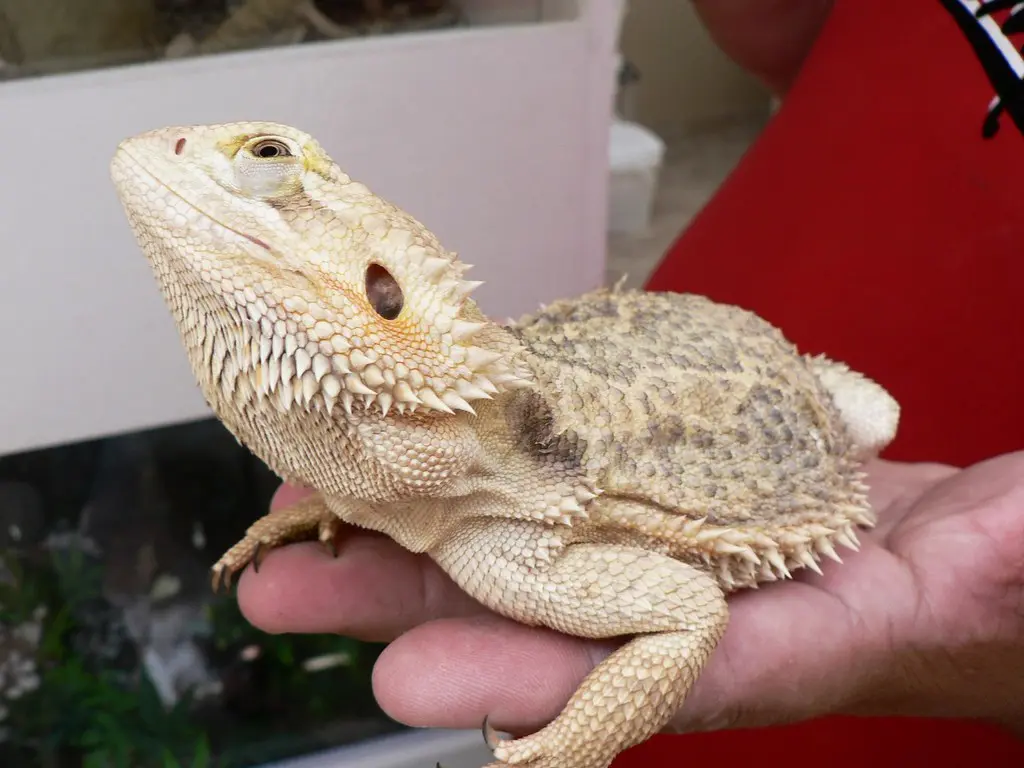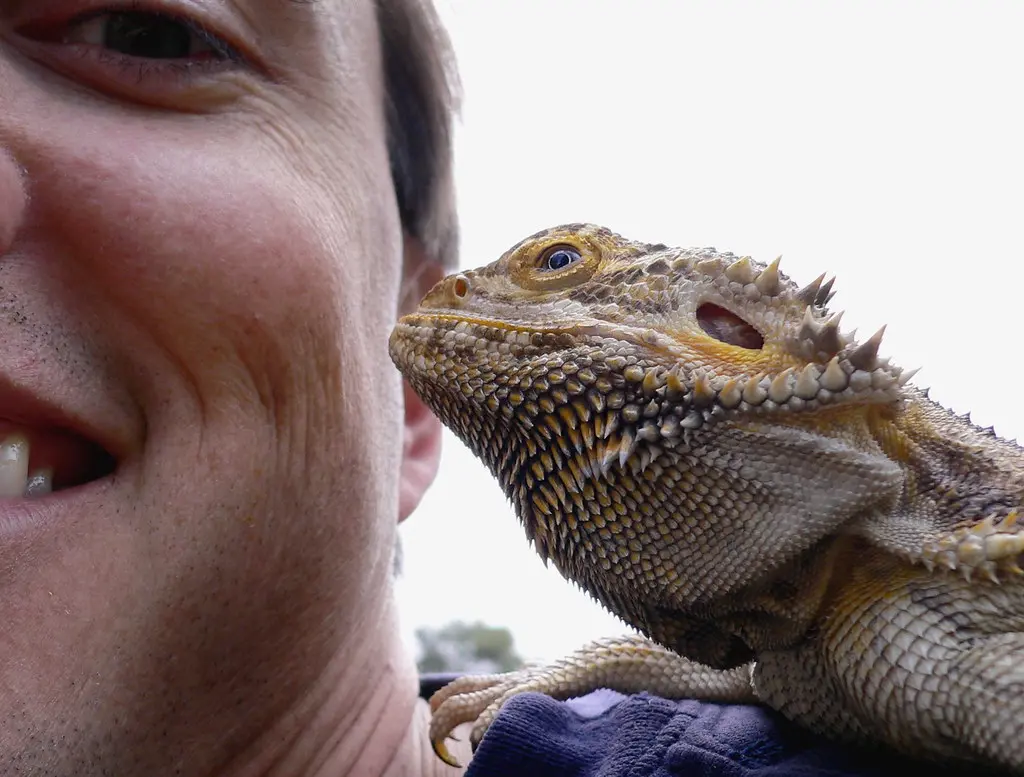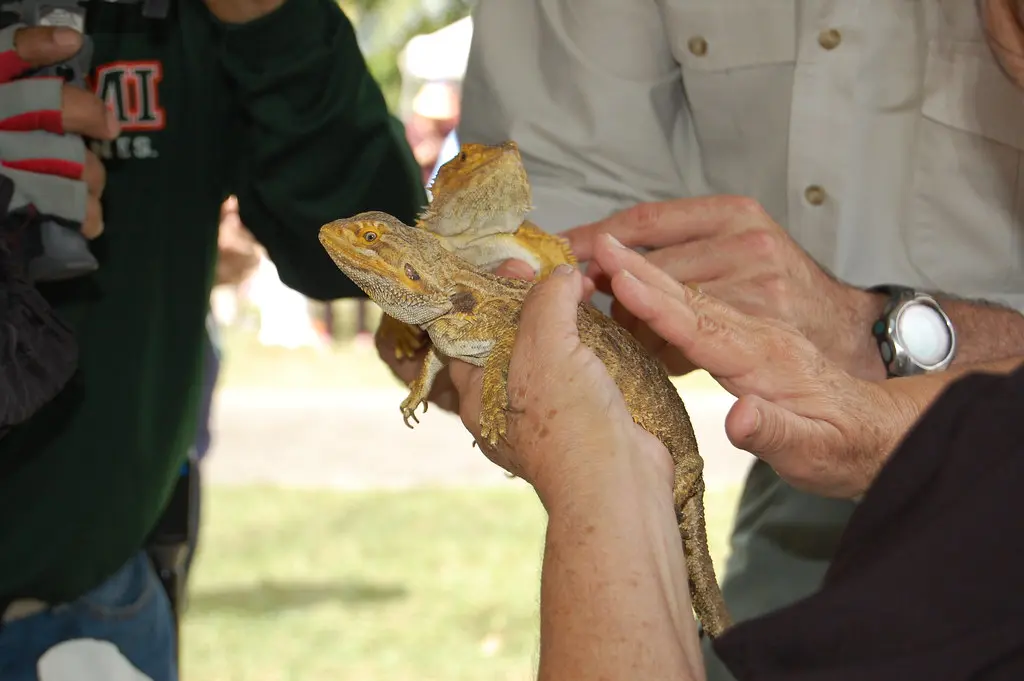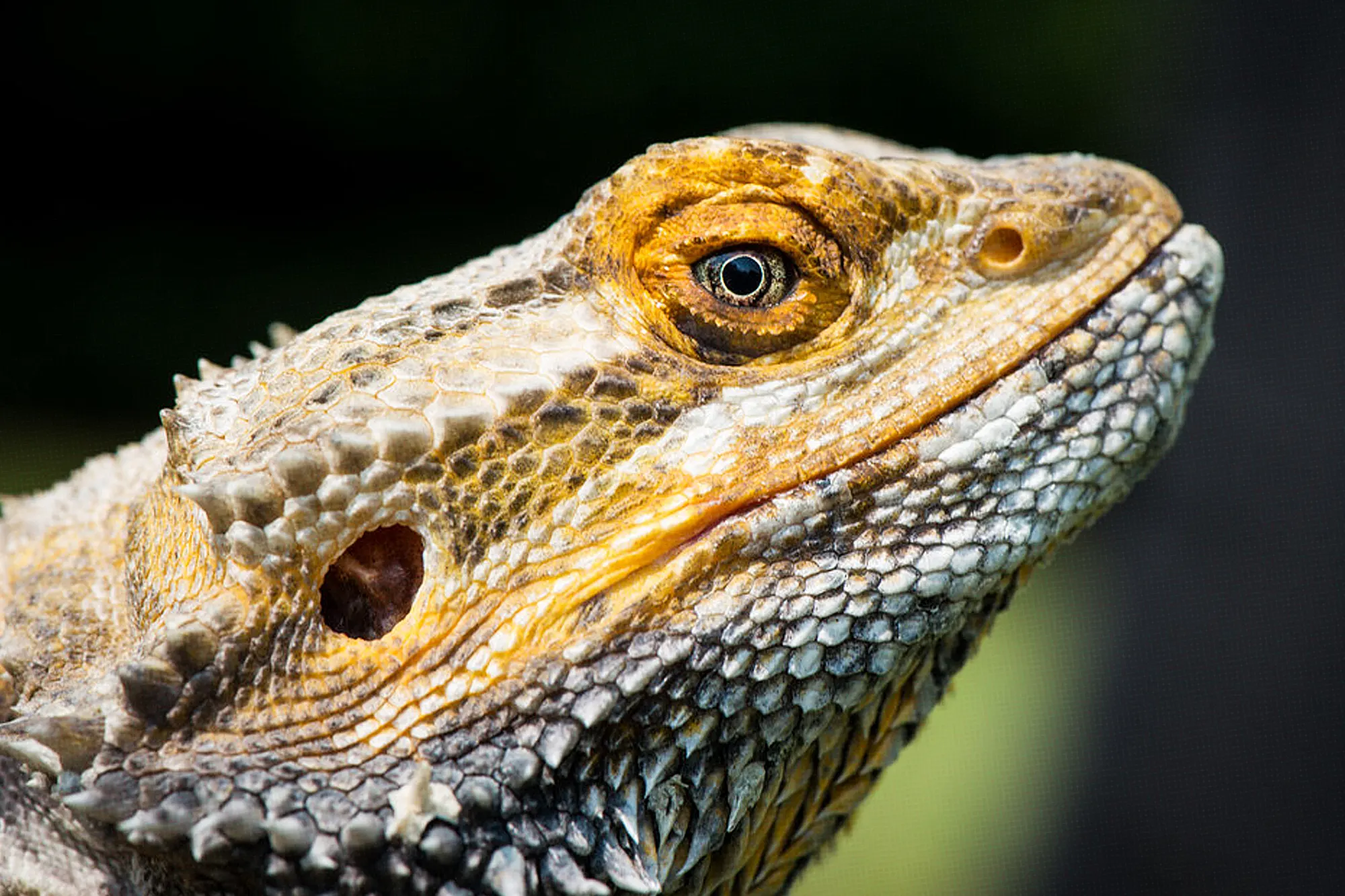Once upon a time, I thought a trendy pet was a dog with an Instagram account. Then, I met the bearded dragon – the lizard world’s equivalent of a rock star. King of the vivarium and master of the side-eye, these spiky companions are so unique that they’re becoming increasingly popular as pets. This blog post is your quick cheat sheet on welcoming one of these Australian natives into your humble abode.
 Bearded Dragons At A Glance
Bearded Dragons At A Glance
Family: Agamidae
Class: Reptilia
Lifespan: 10-15 years
Length: 16-24 inches
Weight: 0.5-1.5 pounds
Energy Level: Low to moderate
Personality: Docile, curious, friendly, and relatively easy to handle
Temperament: Generally calm and non-aggressive
Intelligence: Intelligent reptiles that can respond to commands
What is a Bearded Dragon?

Originate from the great Aussie land, bearded dragons (or “beardies” as they’re affectionately known) are medium-sized lizards blessed with social streak and endearing droopy eyes. As far from the jumpy chameleon as Australia is from Antarctica, these friendly lads love to hang around and observe the world.
Why Adopt a Bearded Dragon?
Now, I know what you might be thinking: “A bearded…what now?!” – fear not, it’s not a mythical creature. Imagine a mini dinosaur, but friendlier and definitely more handleable. Not as soft and fluffy as a kitten perhaps, but with a truckload of personality that’ll make you go “hmm, perhaps I am more of a reptile person than I thought.”
Kind of like how I discovered I was more of an ’80s pop person after hearing Wham!’s ‘Wake Me Up Before You Go-Go’ for the umpteenth time. But I digress…

1. They’re the Life of the Party…Sort of
First off, bearded dragons are interesting pets. Their oddball behavior from unique head-bobbing displays (which is their way of saying “Hello, mate!”) to their kooky lounging positions are guaranteed chuckle-inducers. Who needs a box of Japadog or the newest viral cat video when you have a live performance right at home?
2. Low Maintenance, But High Reward
Compared to the classic dog or cat, bearded dragons are relatively low maintenance. Sure, they require a certain kind of habitat (read: bearded dragon enclosure options) and they have a very specific diet, but they won’t tear up your furniture or require daily walks.
3. They’re Great Conversation Starters
As an added bonus, bearded dragons serve as fantastic icebreakers. Imagine the conversation at the next dinner party when you casually drop, “Oh, let me check if my bearded dragon needs his cricket breakfast.” There’s no surer way to become the unforgettable guest.
4. Lifelong Friends
Bearded dragons are also great companions with a lifespan of 10-15 years. They’ve been known to recognize their human handlers, respond to voice cues, and even watch TV with their dear owner. Plus, I guess there’s something fascinating about that feel of prehistoric scale against your skin. Makes watching Jurassic Park an entirely different experience.
5. Encourage Learning and Responsibility
Lastly, they’re educational. For families with children, adopt a bearded dragon becomes a unique opportunity to explore biology, understand animal behavior, and foster responsibility. Is it just me or did ‘do your homework’ suddenly become more appealing than usual?
6. Beardies Need Love Too!
Let’s not forget, many beardies out there are in need of a caring home. Rescue centers and pet adoption agencies often have bearded dragons that have been given up by past owners who couldn’t care for them. It’s a great chance to offer these fabulous reptiles the love they deserve.
7. You Get To Look Cool
When I first brought home my bearded dragon Jerry, I’ll admit I was mostly in it for the cool factor. I wanted to be able to say “I have a dragon as a pet!” and seem way more interesting than I actually am. As Jerry sunbathed on his rock and stared at me with his beady little lizard eyes, I envisioned all the ways I could work him into conversation to maximize his coolness potential.
Picture this hilarious conversation:
Friend: Hey, what’s up?
Me: Not much, just chilling with my dragon.
Friend: What did you do this weekend?
Me: Oh you know, the usual. Fed my dragon, cleaned his tank, let him crawl around the house breathing fire on stuff.
And of course, I love showing off pictures of Jerry to anyone who will look.
Friends: “Aw that’s cute…is that, uh, a real dragon?” they ask, awkwardly trying to hide their confusion.
Me: “Yup! His name is Jerry. Well, his full name is Jeremy the Welsh Dragon, but we just call him Jerry for short.” I reply, puffing out my chest just a bit.
Cool factor to the max!
Requirements for Bearded Dragon Care: The Checklist

When you look at it, bearded dragon care is about striking the balance — right from having the appropriate tank size and decor to keeping an eye on temperatures, lights, and their Michelin-star menu. Is it an effort? Sure, but it’s one filled with delightful discoveries.
And trust me, when your dragon settles in, starts to bob its head or wave to you (yes, they do that!), it’s a heart-melting moment no cat video on YouTube could match! Here’s are a few tips on how you can give them the best home possible:
1. The Terrarium
You wouldn’t want your Pogona (a fancy scientific name for the bearded dragon) crammed in your old hamster’s cage, right? A juvie beardie needs at least a 20-gallon tank, while adults need an absolute minimum of a 50-gallon – but bigger is always better.
*Fun fact: Dragons love room to loom. Don’t forget to deck out their palace with a secure lid to keep any adventurous escapees in check.
2. Climbing and Hiding Spots
Give your new lizard pal a couple of platforms to pose heroically upon and a place to hide when the world seems too irksome. Wooden branches, synthetic rocks, and reptile caves are the Ikea essentials of the bearded dragon world..
3. Lighting
Believe it or not, dragons are masters of basking — no, not in glory — though they probably do that too. They need a spot to soak up the rays, so you’ll need a basking light for a hot end of the tank. And don’t forget the all-important UVB light; it’s like providing your dragon version of a vitamin D supplement. Remember, lighting is the key to a healthy, beautiful dragon glow.
4. Temperature and Humidity
Let’s face it; bearded dragons are literally cold-blooded! So, monitor their tank temperature religiously. You’ll need a general tank thermometer and a separate one for their basking spot. While you’re at it, grab a humidity gauge. If you get the numbers right, your dragon might just mistake your house for the Australian outback!
5. Diet
Your beardie is basically the Gordon Ramsay of the reptile world – a discerning palate, you might say. Their menu? A balanced mix of vegetables (think vibrant greens, peppers, and squash) and protein-rich live insects, featuring favorites like crickets, mealworms, and roaches. Yes, it’s enough to make your own stomach roil, but what disgusts us is a sautéed delight for our dragons!
6. Water Dish
While our scaly friends may be desert creatures, they still need hydration. A shallow water dish in the tank serves perfectly, and try lightly misting your beardie with water every couple of days.
7. Substrate for the Tank Floor
Here’s a topic that starts as many debates as pineapple on pizza! Some beardie keepers swear by reptile carpet, others by tile, and some just opt for plain old newspaper. More natural substrates like sand should be used with caution due to the risk of impaction. Bottom line? Choose something that’s easy to clean and safe for your pet.
8. Regular Vet Check-ups
Finally, find a vet specializing in reptiles because — surprise, surprise — bearded dragons aren’t dogs or cats! Regular check-ups can help you stay ahead of common health issues and have a healthy, happy beardie!
Adoption: Finding Your Bearded Friend

Navigating the world of bearded dragon ownership can be both thrilling and tricky. This section aims to help you make an informed decision every step of the way.
1. Understanding the Beardie World
Like any major decision, the first step is to educate yourself. Bearded dragons are exotic creatures, each with unique needs, personalities, and behaviors. They are largely docile and friendly, making them excellent companions, but they also require specific care to stay healthy. Research extensively about bearded dragons’ diet, habitat, social needs, or any potential health concerns.
2. To Breed or Not to Breed
While finding a reputable breeder is a good choice, consider giving a home to a beardie in an animal shelter or rescue center. Often, plenty of mature bearded dragons who’ve been abandoned or mistreated are in need of loving homes. Don’t forget to inquire about the bearded dragon’s history if you’re adopting from a rescue center or purchasing from a breeder.
3. Make Your Home a Beardie Haven
Unlike common pets, bearded dragons require specific habitats to thrive. Your new companion will require a spacious terrarium with a heating source, UVB lighting and an area for basking. You also need appropriate substrates, a hiding spot, and climbing opportunities – all encased within a secure casing to keep your dragon friend safe.
4. The Dragon’s Lair Inspection
When adopting, critically analyze the health of the bearded dragon. Look for any signs of illness like irregular body shape, drooping tail, lethargy, poor appetite, or discharge from the mouth, nose, or eyes. if you’re adopting from a breeder, take note of the cleanliness of their facilities and the overall care of their reptiles.
5. Get Ready for Lifelong Commitment
Adopting a bearded dragon isn’t something you take for granted. A bearded dragon can easily become your magical partner for up to 10-15 years. Make sure you are ready for the long-term commitment, and that does not only count for regular feeding and habitat cleaning, but also some lovely exchange of emotions.
6. Connect with a Reptile Vet
Establishing contact with excellent vet near you is equally important. Regular health evaluation and vaccinations will aid in a healthy, happy bearded dragon.
7. Preparing a Hearty Dragon Feast
Bearded Dragons follow a mixed diet, balancing insects, vegetables, and fruit. Regular dusting of the food with vitamin and calcium supplements is also crucial. Ensure you are prepared for the task, including managing live feed like crickets or worms.
8. Embrace the Dragon Parenting
Finally, remember that adopting a bearded dragon means stepping into an incredible journey of companionship and learning. Celebrate every small victory, whether it’s your Beardie accepting food from your hand, playfully gaping, or quietly relaxing on your shoulder as you go about your day.
Things to Consider Before Adopting a Bearded Dragon

Dreaming of becoming a dragon parent? Before you embark on the fulfilling path of bearded dragon companionship, there are a few key considerations to make. Here’s what you need to consider:
1. Do you understand a bearded dragon’s needs?
Bearded dragons have very specific needs. This isn’t a run-of-the-mill pet adoption—taking a beardie home means committing to look after its diet, habitat, and health:
Diet
A well-rounded bearded dragon diet is a delicate balance between meat and greens. Beardies are omnivores with very specific dietary needs. Be prepared to feed your dragon a diverse menu comprising insects (such as roaches, crickets, and mealworms), vegetables, and fruits.
Habitat
Your bearded dragon’s habitat should replicate their native Australian dry-forests and deserts. That includes a large tank (at least 75 gallons for an adult), a basking spot, hideouts, and UVB light to help them synthesize vitamin D and absorb calcium. You might also want an adjustable heat source to create a temperature gradient in the tank.
Health
Like all creatures, bearded dragons can fall ill, and detecting a disease early can help save your beardie’s life. Familiarize yourself with common diseases like Metabolic Bone Disease (MBD) and Atadenovirus. Also, secure a local vet experienced in handling exotic reptiles.
2. Choosing Between Baby and Adult Bearded Dragons
Baby bearded dragons are undeniably cute, but they require more care and food. On the other hand, adults are usually hardier—with their personality, habits, and health condition more predictable.
3. Sourcing Your Bearded Dragon
Where you get your bearded dragon matters. While pet stores might seem convenient, they often lack important details about the dragon’s origin, health condition, and age. A reputable breeder or a rescue shelter (where plenty of adult beardies are in need of loving homes) are usually the best places to turn to.
4. Preparing Your Home for Your Bearded Dragon
Just like you’d prepare a nursery for a new baby, a designated area needs to be prepared for your beardie. This includes setting up and testing the habitat before bringing your scaly friend home. And yes, beardies can be escape artists, so you’ll want that habitat to be as escape-proof as possible!
5. Long-Term Commitment
Bearded dragons live between 10-15 years on average. Adopting a bearded dragon means pledging to provide a loving home for its entire lifespan. Make sure you’re ready for long-term commitment.
6. Financial Considerations
The overall cost to buy the dragon itself might be relatively small compared to the cost to keep it healthy and happy in the long term. A proper setup can cost several hundred dollars. Also consider ongoing costs: food, supplements, potential vet bills, and more.
After Adoption: Bearded Dragon Parent Tips

Once the beardie has checked into Hotel You, it’s all about creating a solid bond. Beardies need clean habitats, nutritious meals, and regular check-ups.
1. The Welcome Party
Nobody likes moving houses – and your new pet probably feels the same way. The first week is all about letting your dragon settle in. Don’t be surprised if they act a bit like a teenager, brooding in their cave or losing their appetite. It’s all pretty normal. Make sure they’ve got their necessities – UVB, basking light, food, water and a snug little hideout, then give them space to explore.
2. Make the First Move
Adoption can be a bewildering process for your scaly friend. Initiate contact, but in a ‘low-contact’ way. Hand-feed them their favorite cricket or worm to show them you’re a friend. Trust me, nothing bonds like a shared meal.
3. Learn the Lingo
Your beardie expresses itself through body language. From arm-waving to head-bobbing, each action carries meaning. So it’s time to brush up your “Dragonese.”
4. The Daily Routine
Creating a regular schedule mimicking natural conditions is key for your beardie’s wellbeing. You, recreating the cycles of day and night? Yep, you’ve basically become Mother Nature.
5. Feed Them Like a Pro
As we’ve established, you’re about to develop a bizarre amount of knowledge about bugs. Yep, bugs. Make sure you’re feeding them the right type (here’s looking at you, mealworms), and remember to dust insects with a calcium supplement. To avoid overfeeding, use the 15-minute rule: offer as many bugs as they can eat in that timeframe.
6. Bath Time
You didn’t expect this, did you? Bearded dragons not only require meals and a photoperiod routine but also regular gentle baths. It’s beneficial for their hydration and helps with shedding. Plus, you get to witness your dragon splashing around in a tub. Surely, a Kodak-worthy moment!
7. Regular Health Check-ups
These guys may seem like they’re armored, but they’re not impervious to health issues. Regular check-ups with a vet will make sure your bearded buddy stays in peak health.
8. Play and Interact
Dragons – social creatures? Absolutely! Interaction outside the terrarium not only stimulates their mind but also strengthens your bond with them. Just remember: safety first. Always supervise these adventures.
9. Don’t Forget the Love!
After all, your bearded dragon is part of your family. Cuddle them, get to know their quirks and personality, and most importantly, let them know they are loved. That’s the secret ingredient to a happy, healthy beardie.
10. Maintenance and Healthcare
Much like us, bearded dragons need a bit of TLC to stay fit and fabulous.
- Cleaning: Nobody likes a stinky home! Make sure you remove any leftover food and waste daily. Thoroughly disinfect your beardie’s villa every month.
- Health Checks: Keep an eye on your bearded dragon’s body condition. A happy, healthy beardie should have bright and clear eyes, an undamaged and functional tail, and should show signs of activity.
- Vet Visits: If you notice anything unusual – like cloudy eyes, lethargy, or weight loss – take your bearded buddy to a reptile-savvy vet.
Final Thoughts
And that’s about it – the A-Z modern guide to adopting a bearded dragon! We’ve covered everything from understanding their natural habitat and dietary needs to creating a suitable habitat and providing proper care. By now, you should have a comprehensive understanding of what it takes to be a responsible and knowledgeable bearded dragon owner.
If you have any questions, we’ll be in the comments.
